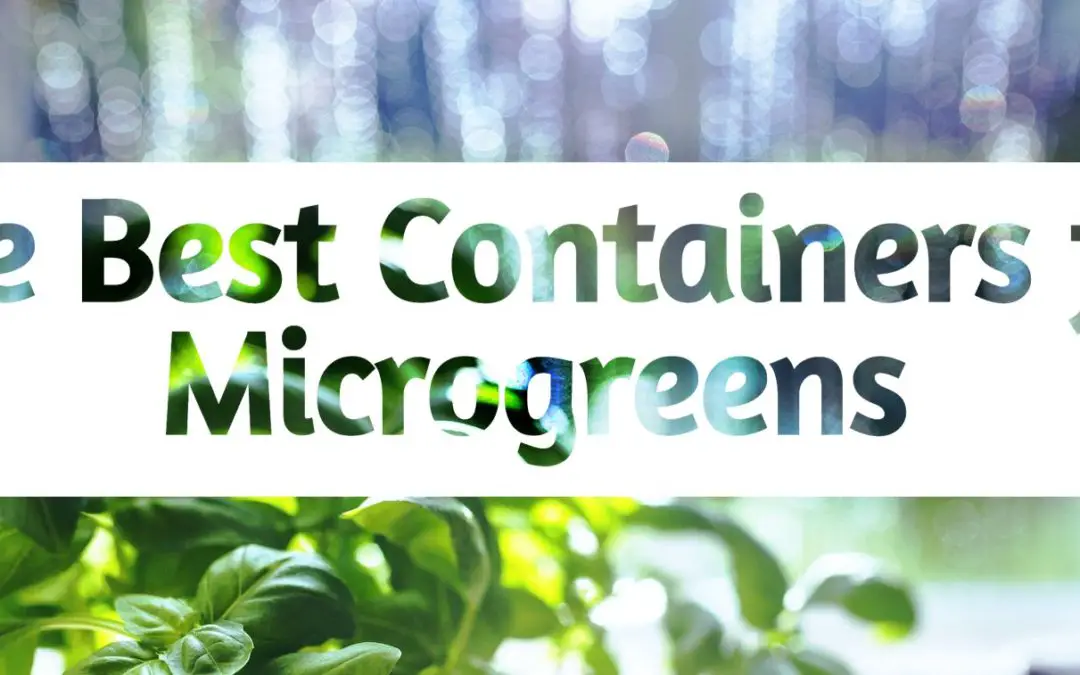Maybe you’re just starting out with microgreen growing!
What an exciting time.
Or maybe you just want to grow microgreens in the most efficient, or most beautiful way.
Either way, step 1 is get some seeds, and step 2 is to soak (some species) and plant them!
But plant them in what?
What is the best container for growing microgreens?
An ideal container for growing microgreens is 1” to 2” deep, has drainage holes, and is easy to clean. Look online or at local garden supply centers or plant nurseries and you’ll find a lot of good options.
And just so we’re clear, we’re talking about microgreens here, not sprouts. Read more about the difference here.
And if you were looking for packaging containers, I put a ton of research in and wrote up an article that you can find here. You’ll definitely find a new idea or two.
So, what are some considerations for a good microgreens growing container?
What makes a good microgreen container?
Microgreens are the young seedlings harvested at 1-3 week old from many vegetable, herb and edible flower seeds. Think of them as a slightly older sprout, or a slightly younger baby green.
Look for a microgreen container that’s:
- 1” to 2” deep
- Has good drainage
- Is easy to clean: you want smooth material if possible, so it doesn’t retain moisture and grow mold and other critters in the cracks and crevices. This is especially important indoors. Outdoors there’s more natural competition between micro-organisms so you can probably get away with wood (porous and harder to clean).
- Made of a food safe material: there’s no negotiating on this one, don’t use anything you aren’t sure is food safe. For example don’t use treated wood, or plastic with recycling codes 1, 3, 6 or 7 (2, 4 and 5 are generally considered safe)
- Is easy to cover: blackout periods are critical for microgreen success. Blacking out is just covering the seeds in the dark to trap in moisture, and it’s really important.
- Durable: Especially for plastic trays, you don’t want a container that’s going to crack if you drop it, or dump your microgreens because it’s so floppy and flexible. Buy durable trays so you can buy them one, it’s more sustainable, and it’s less headache.
Because microgreens are harvested so early, they’re usually 1” to 3” tall when you harvest them, so the container can’t be too deep, otherwise it will be harder to harvest.
Imagine if you plant your microgreens in a 5” deep container. Then when it’s time to harvest you have to reach down into the container with your scissors or harvesting tool.
That’s tricky!
Alternatively you could try to pull the microgreens (root and soil and all) out of the container and then harvest. But the problem with that is you’ll probably get soil all over your microgreens.
Soil can have a lot of bacteria, fungi and other microorganisms on it, that you don’t want to eat, and don’t want to come into contact with your microgreens.
So, the best thing to do is go for that 1” to 2” deep container.
Most things you can think of will work!
A really common option is to use nursery seedlings tray. I link to my two top picks here.
Other considerations for your microgreens growing containers
- Keep them warm! Room temperature or a few degrees below is ideal. Too cold and growth will slow down. Too warm and you’ll start to encourage mold and microbial growth which can cause a lot of problems. More on that here and here.
- Use good quality soil. Microgreens absorb nutrients from the soil, unlike sprouts. And since they’re only growing for a week or two, and don’t use much soil at all, it’s a good idea to use high quality potting soil. More info on microgreens soil, and whether or not you can reuse it here.
- Have an easy way to cover it. A critical step for most microgreens (find the basic microgreen steps here) is to cover the seeds for a dark germination period called the blackout period. By covering the seeds you hold in moisture, and get WAY more even germination and yields. Nursery flats are great because you can just put an empty one on top of the one you have your soil and seeds in, easy!
Can you grow microgreens in a jar?
Another common question that comes up is about growing microgreens in jars.
A lot of people are familiar with growing sprouts in jars, so it’s natural to wonder if you can use the same setup for growing microgreens.
I get into a good discussion on this topic in my article here:
Can you grow Microgreens in Jars?
Microgreen Container Inspiration
You can have a lot of fun with picking containers and planters to grow in. Microgreens can be grown inside or outside, so the options are almost limitless!
I made a Pinterest gallery to share some inspiration, check it out!
My pinterest Gallery:
Best Containers from Growing Microgreens (Link to Pinterest)
Regulations
If you’re growing commercially, you definitely don’t want to get into hot water with health inspectors and regulatory agencies. So, do a bit of reading and make sure you’re using materials that are food-safe, and approved in your area.
Regulations are pretty relaxed in the USA for the most part, but Europe and some parts of Canada can be pretty strict.
If you’re just collecting information, it can be a good idea not to volunteer too much information.
I’ve even heard of people borrowing a phone to make the calls, and giving false information so they can’t track you down for a “random” inspection.
I would never advise such deception. ; )
What containers do I use and why?
I use 1” deep microgreen flats, a solid one on the bottom, and a perforated one on top. This lets me water between the trays (sub-irrigation), which seems to help with reducing mold, and doesn’t disturb the delicate root hairs and gets less soil on the finished microgreens).
These trays also go by a few different names:
- growing trays
- microgreen trays
- nursery flats
You can find the exact trays I use here on my page about buying microgreen trays.
I’m interested in experimenting with stainless steel restaurant trays. Stainless steel is very inert (doesn’t react with, absorb, or leech most chemicals), but I’m curious if it has any reaction with wet soil.
I know it’s food safe for storing food (it’s used in 100% of commercial kitchens, show me one that doesn’t!), but I don’t know about using it for growing.
It’s also easy to clean, and almost indestructible, so you manufacture it once, and it’s probably good for 100 years or more. That’s pretty cool.

I’m Alex Lafreniere. I learned a lot about plants when I built and operated a landscaping company. I learned even more when I started growing and selling Microgreens. But, learning is a journey, not a goal. Ever since travelling across the world, I’ve wanted to find ways to bring more delicious and exotic plants into my life. This is the site where I share everything I’ve learned with you. And maybe we’ll learn a thing or two together.
This site is owned and operated by Plant Hardware, a sole proprietor headquartered in Calgary, Canada. Plant Hardware is a participant in the Amazon Services LLC Associates Program, an affiliate advertising program designed to provide a means for sites to earn advertising fees by advertising and linking to Amazon.com. Plant Hardware may also participate in affiliate programs with Bluehost, Clickbank, CJ, ShareASale, and other sites. Plant Hardware is compensated for referring traffic and business to these companies.

